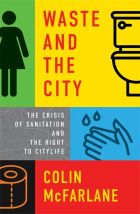Waste and the City: The Crisis of Sanitation and the Right to Citylife

In the words of the author, the sanitation crisis this book describes is not some abstraction. The lack of provision is being lived by hundreds of millions now, as people wake in the morning, go to school or work, take the bus or train, visit the local market, or move through the neighbourhood in the evening. It is present in physical exhaustion, illness, disease, harassment and violence. It ruins education, health, jobs and family relationships. It is at work in moments of social shame and desperate protest. It is seeping into soils, rivers, food, and water supplies.
This book “aims to bring sanitation and the city firmly together, to ask what difference one makes to the other, and in so doing to place sanitation into a network of concerns ranging across people, infrastructure, and protest movements; animals, microbes, and climate change; and institutions, land, and housing.” It covers sanitation issues from all the key actors – from the UN’s global discussions and goals to community toilets built and managed by women’s savings groups in informal settlements.
The text is organized under seven chapters: The Right to Citylife; People; Things; Life; Protest; Allocation; and Conclusion. The author notes how prospects for the right to citylife rests on a world of things: toilets, pipes, drains, septic tanks, sludge and sewers each in their own way, and together, fundamental elements in the everyday life of the sanitary city.
The book has strong, interesting case studies in sanitation and the city that include coverage of the global North as well as the global South. One example of this from the United States, is the 2005 Restroom Access Act. Also known as ‘Ally’s Law’, this make employee toilets available to any member of the public with certain medical conditions; this came from the experience of a fourteen-year-old girl, Ally Bain, who has Crohn’s disease. When shopping with her mother she needed a toilet only to find there were no public facilities and she was denied access to the staff toilet.
The book discusses four closely interrelated systems for allocation that play vital roles in the relationship between sanitation and the right to citylife: money, land and housing, utilities and communities. The author explores how resources are allocated and how responsibility is understood in the sanitation crisis. While there needs to be a commitment to good sanitation provisions across the city, from the home to the bus station and public square, sanitation solutions also must be flexible enough to respond to the social heterogeneity we find in cities and to the specific needs and limits of different contexts. ‘Sanitation for all’ is a universal; the route to it is not.
Book note prepared by David Satterthwaite.
Search the Book notes database
Our Book notes database contains details and summaries of all the publications included in Book notes since 1993 - with details on how to obtain/download.
Use the search form above, or visit the Book notes landing page for more options and latest content.
For a searchable database for papers in Environment and Urbanization, go to http://eau.sagepub.com/

